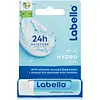What's inside
What's inside
 Key Ingredients
Key Ingredients

 Benefits
Benefits

 Concerns
Concerns

 Ingredients Side-by-side
Ingredients Side-by-side

Octyldodecanol
EmollientRicinus Communis Seed Oil
MaskingCera Alba
EmollientHelianthus Annuus Seed Cera
EmollientButyrospermum Parkii Butter
Skin ConditioningPolyglyceryl-3 Diisostearate
EmulsifyingButyl Methoxydibenzoylmethane
UV AbsorberEthylhexyl Triazone
UV AbsorberHydrogenated Castor Oil
EmollientWater
Skin ConditioningGlycerin
HumectantTocopherol
AntioxidantAscorbyl Palmitate
AntioxidantHelianthus Annuus Seed Oil
EmollientLinalool
PerfumingCitronellol
PerfumingCitral
PerfumingAroma
Octyldodecanol, Ricinus Communis Seed Oil, Cera Alba, Helianthus Annuus Seed Cera, Butyrospermum Parkii Butter, Polyglyceryl-3 Diisostearate, Butyl Methoxydibenzoylmethane, Ethylhexyl Triazone, Hydrogenated Castor Oil, Water, Glycerin, Tocopherol, Ascorbyl Palmitate, Helianthus Annuus Seed Oil, Linalool, Citronellol, Citral, Aroma
Octyldodecanol
EmollientRicinus Communis Seed Oil
MaskingHydrogenated Rapeseed Oil
EmollientBeeswax
Emulsion StabilisingCetyl Palmitate
EmollientEthylhexyl Methoxycinnamate
UV AbsorberButyrospermum Parkii Butter
Skin ConditioningPolyglyceryl-3 Diisostearate
EmulsifyingBis-Diglyceryl Polyacyladipate-2
EmollientCetearyl Alcohol
EmollientOctocrylene
UV AbsorberPersea Gratissima Oil
Skin ConditioningSimmondsia Chinensis Seed Oil
EmollientTocopheryl Acetate
AntioxidantPanthenol
Skin ConditioningBisabolol
MaskingWater
Skin ConditioningGlycerin
HumectantBHT
AntioxidantLimonene
PerfumingGeraniol
PerfumingLinalool
PerfumingBenzyl Alcohol
PerfumingParfum
MaskingTitanium Dioxide
Cosmetic ColorantOctyldodecanol, Ricinus Communis Seed Oil, Hydrogenated Rapeseed Oil, Beeswax, Cetyl Palmitate, Ethylhexyl Methoxycinnamate, Butyrospermum Parkii Butter, Polyglyceryl-3 Diisostearate, Bis-Diglyceryl Polyacyladipate-2, Cetearyl Alcohol, Octocrylene, Persea Gratissima Oil, Simmondsia Chinensis Seed Oil, Tocopheryl Acetate, Panthenol, Bisabolol, Water, Glycerin, BHT, Limonene, Geraniol, Linalool, Benzyl Alcohol, Parfum, Titanium Dioxide
Ingredients Explained
These ingredients are found in both products.
Ingredients higher up in an ingredient list are typically present in a larger amount.
This ingredient is also known as shea butter. It is an effective skin hydrator and emollient.
Emollients help soothe and soften your skin. It does this by creating a protective film on your skin. This barrier helps trap moisture and keeps your skin hydrated. Emollients may be effective at treating dry or itchy skin.
Shea butter is rich in antioxidants. Antioxidants help fight free-radicals, or molecules that may harm the body. It is also full of fatty acids including stearic acid and linoleic acid. These acids help replenish the skin and keep skin moisturized.
While Shea Butter has an SPF rating of about 3-4, it is not a sunscreen replacement.
Shea butter may not be fungal acne safe. We recommend speaking with a professional if you have any concerns.
Learn more about Butyrospermum Parkii ButterGlycerin is already naturally found in your skin. It helps moisturize and protect your skin.
A study from 2016 found glycerin to be more effective as a humectant than AHAs and hyaluronic acid.
As a humectant, it helps the skin stay hydrated by pulling moisture to your skin. The low molecular weight of glycerin allows it to pull moisture into the deeper layers of your skin.
Hydrated skin improves your skin barrier; Your skin barrier helps protect against irritants and bacteria.
Glycerin has also been found to have antimicrobial and antiviral properties. Due to these properties, glycerin is often used in wound and burn treatments.
In cosmetics, glycerin is usually derived from plants such as soybean or palm. However, it can also be sourced from animals, such as tallow or animal fat.
This ingredient is organic, colorless, odorless, and non-toxic.
Glycerin is the name for this ingredient in American English. British English uses Glycerol/Glycerine.
Learn more about GlycerinLinalool is a fragrance and helps add scent to products. It's derived from common plants such as cinnamon, mint, citrus, and lavender.
Like Limonene, this ingredient oxidizes when exposed to air. Oxidized linalool can cause allergies and skin sensitivity.
This ingredient has a scent that is floral, spicy tropical, and citrus-like.
Learn more about LinaloolOctyldodecanol is a fatty alcohol. It is primarily used to enhance the texture of products.
As an emulsifier, Octyldodecanol helps prevent the oils and waters from separating. It also prevents ingredients from creating foam when shaken.
Octyldodecanol is created by reducing fatty acid to an alcohol.
Due to its high molecular weight, it does not get absorbed into the skin.
Learn more about OctyldodecanolPolyglyceryl-3 Diisostearate is an emulsifer and emollient. It comes from Isostearic Acid and Polyglycerin-3.
As an emulsifier, it helps stabilize products by preventing oils and water from separating.
This ingredient may not be Malassezia folliculitis, or fungal acne safe.
Learn more about Polyglyceryl-3 DiisostearateRicinus Communis Seed Oil is the INCI name for castor oil.
Castor Oil helps moisturize the skin. It is rich in a fatty acid called ricinoleic acid. This fatty acid helps prevent moisture loss on the skin. This helps keep your skin soft and hydrated. Ricinoleic acid also has anti-inflammatory and pain reducing properties.
Besides hydrating the skin, castor oil is also used to hydrate hair. By keeping the hair shaft moisturized, breakage is decreased. More studies are needed to show castor oil's effective on stimulating hair growth.
Castor oil is created by cold-pressing castor seeds and then purifying the oil with heat. It was used in Ancient Egypt as fuel in lamps and to help treat eye irritation.
The term 'fragrance' is not regulated in many countries. In many cases, it is up to the brand to define this term. For instance, many brands choose to label themselves as "fragrance-free" because they are not using synthetic fragrances. However, their products may still contain ingredients such as essential oils that are considered a fragrance.
Learn more about Ricinus Communis Seed OilWater. It's the most common cosmetic ingredient of all. You'll usually see it at the top of ingredient lists, meaning that it makes up the largest part of the product.
So why is it so popular? Water most often acts as a solvent - this means that it helps dissolve other ingredients into the formulation.
You'll also recognize water as that liquid we all need to stay alive. If you see this, drink a glass of water. Stay hydrated!
Learn more about Water